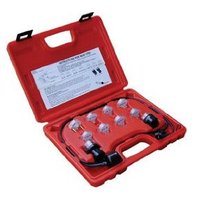
Testing fuel injectors may become necessary when dealing with a stubborn rough running engine condition. I'm sure you have seen many commercials about fuel injector cleaners and maybe even advertisements from gas companies stating if you use their fuel your engine will run better and cleaner.
Fuel injection cleaning services are also a popular up sell at many auto repair facilities. Often these cleaners and services are purchased for good measure without actually knowing if they are needed. These gas delivering components can be tested and diagnosed.
An injector is nothing more than an electrically operated solenoid that is actuated to allow fuel to flow at a set rate. Although many think that this is a complicated component the operation is actually quite basic. The solenoid is energized and held open until it delivers the correct amount of gas and then turned off.
Fuel injector problems

Injectors that are dirty or have failed completely will either be stuck in the open or closed position. An injector that does not open can cause hard starts, lack of power and the rough running condition.
An injector that is stuck partially open can cause loss of fuel pressure and can allow raw gas to leak into the cylinder and down into the oil sump.
After this goes on for a while you might be able to pull the dipstick and possibly notice an over filled oil level condition. Another sign that raw fuel is leaking into the oil is the smell of raw gas mixed with the engine oil. This can often be strong enough that you can smell it on the dip stick when checking the oil level.
Another telltale sign of a leaking injector would be an engine run on condition. This is also known as engine dieseling.
Basically this is when you turn off the key to shut down the engine and it continues to run on or clatter and sputter instead of turning off completely and immediately.
A dirty fuel injector is a possible cause of the above conditions. Build up of gum or carbon deposits on the tip of the injector can prevent it from sealing completely when the solenoid is not energized. This allows raw fuel to continue to enter the cylinder. This is then ignited by heat and compression like a diesel engine. Note the closer the injector is to the engine the more heat it is exposed to and the more likely a gummy deposit can develop.
How to test fuel injectors

The first thing for testing fuel injectors is to make sure that the electrical side of the circuit is working correctly. They make a test device that plugs into the injector connector known as noid light.
This will light up when the injector is being signaled to open and stay lit until the unit is closed. This can test the entire engine management side on some models.
You can also test the resistance of the injector itself with an ohm meter. resistance should be within a given range again dependent on the specific model being tested.
When I find that the injectors are being fired correctly and electrically sound the next thing I do is to perform an injector balance test. This test can help isolate clogged, dirty, or inoperative injectors.
Different engines will have different procedures for performing this test and a vehicle specific auto repair manual is recommended for testing. Using a General Motors vehicle as an example what you do is connecting a fuel pressure gauge to the test port on the fuel rail.
You turn the key on (engine off) to build pressure in the fuel rail. With the key on and the engine off you then mechanically trigger each injector and record how much the fuel pressure drops in the rail.
They make injector test equipment (on the left) to help accomplish this. When each individual injector is mechanically activated it should drop the fuel pressure in the rail the same amount as on the others.
Manufacturers will usually include a plus or minus tolerance of 2-3 PSI as an allowable variance. If you have one injector that drops 10 PSI and the other injectors drop 25 PSI then the injector with the low flow rate needs to be inspected.
When you are testing fuel injectors, units with low pressure drops are the ones to look out for. When the tip or orifice is dirty or severely restricted you will find that there will not be much pressure decrease when it is energized. These may need to be cleaned with professional injector cleaning tools (below) or it may need to be replaced.

No comments:
Post a Comment